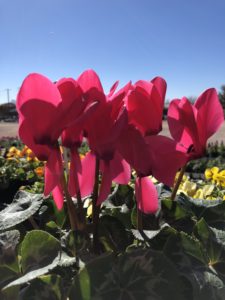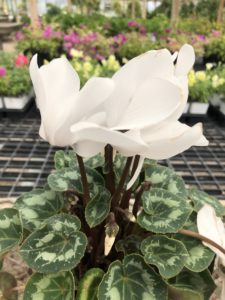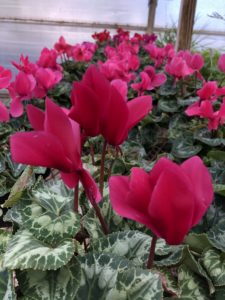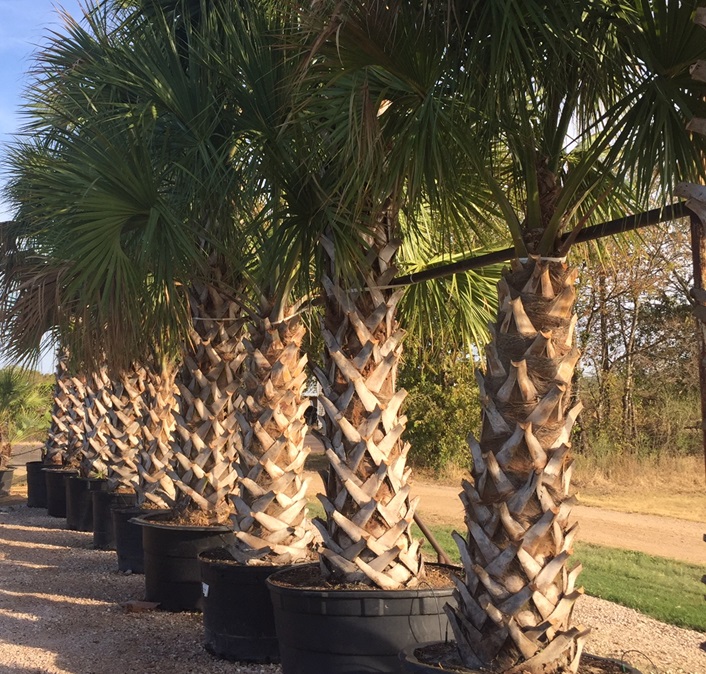Cyclamen come to us from the Mediterranean region and North Africa. They revel in cool, but not cold, temperatures, and provide us with flowers for several weeks each season. Florist Cyclamen come in shades of red, pink, white, purple and salmon.

Some varieties are fragrant, some reach 7”-8” tall, and others may reach 12”-18” tall. They are grown from a corm, which is bulb-like structure, and can be kept over as a perennial as long as they are allowed to go dormant in the summer season. (Or not, as you will read below!)

Locate your Cyclamen where it will receive bright, indirect light with optimal daytime temperatures around 68°F and nighttime temperatures around 50°F. They are best kept outdoors in pots, and brought inside only when temperatures drop to freezing. The flowers will freeze at 32°F and the plants will freeze at 28°F. Covering them or bringing them in for a frost would be advised if they are not under a tree canopy, which will “catch” the frost. Remember, it can frost at 40°F if there is no wind and skies are clear.
If you decide to plant Cyclamen in the ground, you will need to monitor daily weather reports and cover them with cloth if temperatures are to dip below freezing. Since frost cloth only offers a few degrees of protection, a blanket or comforter may offer more protection. Be sure to elevate it slightly above the plants so they are not crushed, and anchor the fabric to the ground to capture ground heat.

I have never been successful in keeping Cyclamen indoors. My house is just too warm and dry. The key to keeping them indoors is to have bright light, high humidity and cool temperatures. (Remember to keep them away from drafts from the AC/Heat vents.) If your house is kept warm and humidity is low, it is best to keep them in dappled shade outdoors, and bring them in when the temperatures drop.


Water Cyclamen when the top inch or so of soil has dried, but before the plant wilts. Avoid getting water in the crown of the plant, and do not allow the plant to sit in excess water, as this will promote rotting of the crown. Fertilize with a low-Nitrogen fertilizer at half-strength every two weeks during the winter months.
Deadhead (remove spent blooms) by grasping the flower stalk and following it to the base of the plant. Give it a gentle tug, and it should come loose. Remove spent or yellow leaves in the same way. Do not cut, as this opens up an entrance for disease to infect the plant.
As a cautionary measure, keep them out of reach of pets, as they may cause digestive problems with dogs and cats.
Sometimes Cyclamen will go dormant when the temperatures rise in late April. When the leaves start to yellow, stop watering it and place it in a cool, dark spot in your house, or a shady spot in the garden. Remove all leaves as they fade. Be sure to turn the pot on its side outside so rain will not keep it too wet and cause it to rot. In September begin watering again and only fertilize when leaves appear. With luck, you will be graced with beautiful blooms once again!
As a side note: I have actually had Cyclamen thrive in a dappled shade spot in my yard all summer long, with flowers even appearing sporadically. Just do not over-water or let it wilt, and you may be able to enjoy your Cyclamen year-round as I have.




